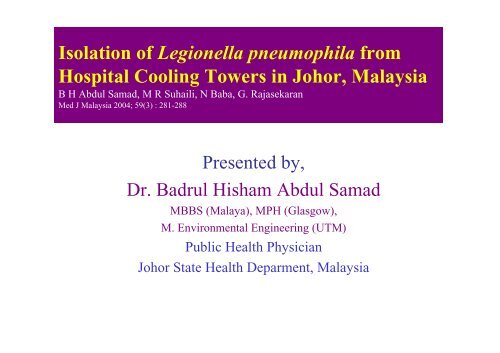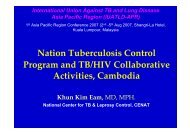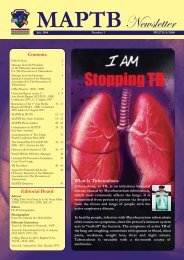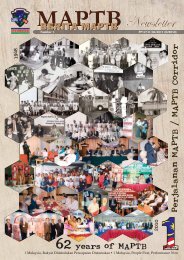Isolation of Legionella pneumophila from Hospital Cooling ... - MAPTB
Isolation of Legionella pneumophila from Hospital Cooling ... - MAPTB
Isolation of Legionella pneumophila from Hospital Cooling ... - MAPTB
You also want an ePaper? Increase the reach of your titles
YUMPU automatically turns print PDFs into web optimized ePapers that Google loves.
<strong>Isolation</strong> <strong>of</strong> <strong>Legionella</strong> <strong>pneumophila</strong> <strong>from</strong><strong>Hospital</strong> <strong>Cooling</strong> Towers in Johor, MalaysiaB H Abdul Samad, M R Suhaili, N Baba, G. RajasekaranMed J Malaysia 2004; 59(3) : 281-288Presented by,Dr. Badrul Hisham Abdul SamadMBBS (Malaya), MPH (Glasgow),M. Environmental Engineering (UTM)Public Health PhysicianJohor State Health Deparment, Malaysia
The Pathogen<strong>Legionella</strong> <strong>pneumophila</strong>
The <strong>Cooling</strong> Tower (CT) System
Mode <strong>of</strong> Transmission
Mode <strong>of</strong> Transmission
PathogenesisReplicative cycle <strong>of</strong> L. <strong>pneumophila</strong> within monocytes
PathogenesisInfected alveolar macrophage
Legionnaires’ Disease (LD)CXR showing legionella pneumonia
Problem Statement• Based on findings <strong>of</strong> <strong>Legionella</strong> <strong>pneumophila</strong> inbuilding complexes cooling towers (CTs) inKuala Lumpur 1 and hospital CTs in Singapore, 2therefore, it is possible that the pathogenicbacteria are also present in hospital CTs in Johor.1. Ngeow YF, Tan CH, Lim SY. <strong>Legionella</strong> species isolated <strong>from</strong> cooling towers in KualaLumpur. Med J Malaysia 1992; 47(1) : 15-19.2. Quarantine and Epidemiology Department. Legionellosis. In : Communicable diseasesurveillance in Singapore 1999. Singapore : Ministry <strong>of</strong> Environment, 2000. 6-1 – 6-14.
Objectives1. To determine the presence <strong>of</strong> <strong>Legionella</strong> bacteriain the hospital CTs2. To compare isolation rate <strong>of</strong> <strong>Legionella</strong> bacteriain the CTs with and without cleaning and/ortreatment maintenance programme3. To associate the isolation rate <strong>of</strong> <strong>Legionella</strong>bacteria with water parameters like temperature,pH, turbidity, and free chlorine content
Study Design• An environmental survey on all water-based CTs• Convenient sampling at two selected hospitalsnamed as the <strong>Hospital</strong> A and the <strong>Hospital</strong> B
Sampling Sitesiviiiiii
Sampling Site i
Sampling Sites ii & iii
Sampling Site iv
Water Parameters tested in situ
Laboratory Procedures
Laboratory Procedures
Control Isolate
Trial Run
Direct Fluorescent Antibody Test
Study Findings1. <strong>Legionella</strong> isolations in hospital CTs
Table 1. <strong>Isolation</strong> <strong>of</strong> L. <strong>pneumophila</strong> <strong>from</strong> <strong>Hospital</strong> A and <strong>Hospital</strong> B cooling towersby different sampling site and treatment method.
Table 2. Identification <strong>of</strong> L. <strong>pneumophila</strong> by DFA test grading and serogrouping.
Study Findings2. <strong>Isolation</strong> <strong>of</strong> <strong>Legionella</strong> <strong>pneumophila</strong> in the CTs withand without cleaning and treatment maintenanceprogramme
Table 3. <strong>Isolation</strong> <strong>of</strong> L. <strong>pneumophila</strong> and summary <strong>of</strong> CT maintenanceprogrammes at <strong>Hospital</strong> A and <strong>Hospital</strong> B.
Study Findings3. Associations with water parameters
Table 4. Association between water parameters and number <strong>of</strong> day intervals between CTtreatment and water sampling.
Limitations• Sampling Method and the Sampling Size• Sampling Day• Quantitative Method
Conclusions• L. <strong>pneumophila</strong> were prevalent in both hospitalswith the <strong>Hospital</strong> A has a potential LD outbreak• High pH and free chlorine content wouldeliminate <strong>Legionella</strong> bacteria but may lead toscale and fouling formations• <strong>Isolation</strong> <strong>of</strong> L. <strong>pneumophila</strong> in the CT watersupply is equally alarming• The <strong>Hospital</strong> B had better engineering practicethan the <strong>Hospital</strong> A
Recommendations1. Good Engineering Practice2. Intervention Measure and Follow-up3. CT Survey at Other High Risk Public Places4. <strong>Legionella</strong> <strong>Isolation</strong> at Other Man-made Devices5. An Environmental Surveillance6. Molecular Identification <strong>of</strong> <strong>Legionella</strong> Strains
Recommendations7. A Clinical Surveillance(Legionellosis Notification)8. Clinical Diagnostic Kits and Markers9. Awareness Programme10.Law and Regulations11.Further Research
Acknowledgements• Director <strong>of</strong> HealthJohor State Health Department• Department <strong>of</strong> Medical Microbiology, Faculty <strong>of</strong> Medicine,University <strong>of</strong> Malaya• School <strong>of</strong> Science & Engineering, Monash University Malaysia• Institute <strong>of</strong> Environmental & Water Resource Management UTM• Quarantine & Epidemiology Department,Ministry <strong>of</strong> Environment SingaporeThank You








